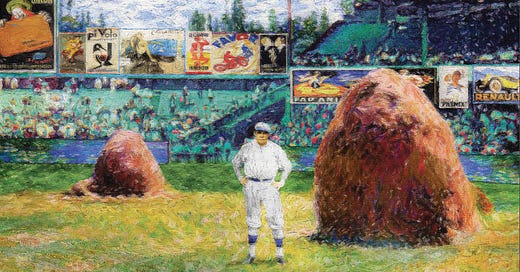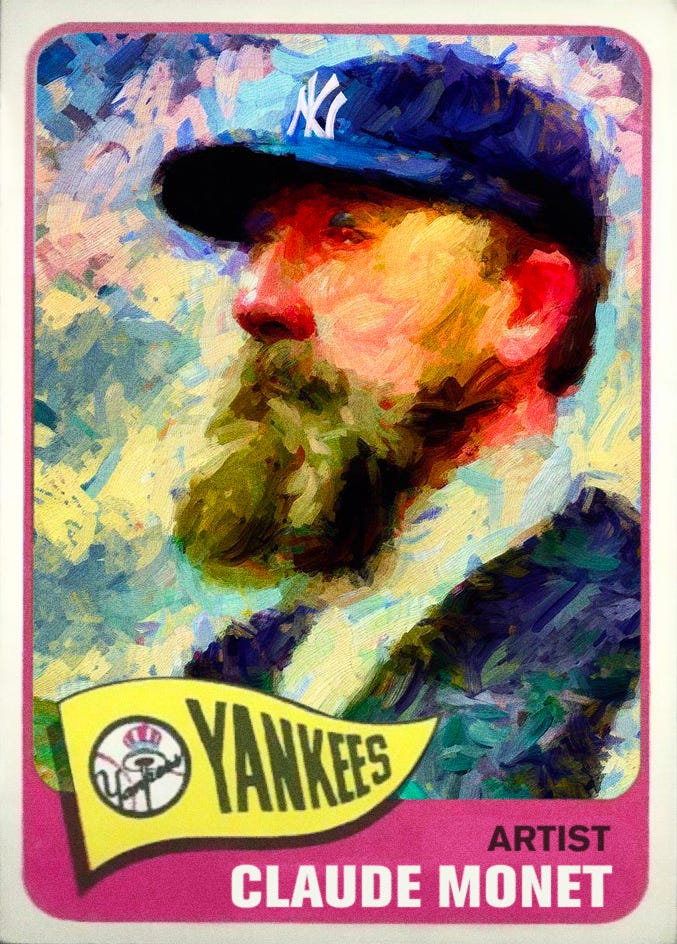"Claude Monet Designs Yankee Stadium — The Original Paintings" Opens Tonight in Prosperity!
by Betsey DeMarco, Head Librarian, Prosperity, Pennsylvania
For Immediate Release, April 1, 2025
The Prosperity Public Library is proud to announce that the greatest art discovery of the 21st century, Claude Monet’s eight visionary paintings that supported his design proposal for Yankee Stadium in 1921, will be showcased in its Lucretia Fleetwood Pulver Gallery.
An Opening Gala Celebration will take place this evening, April 1st, from 7:30 to 10:00 p.m. R. Lee Procter, author of the book “Claude Monet Designs Yankee Stadium — A Love Story” will reveal the astonishing story of how a Security Guard at the New York Metropolitan Museum of Art discovered 700 million dollars worth of original Claude Monet artwork inside the wall of a derelict building a scant four years ago. The exhibit will continue through June 1st.
The paintings include:
“’Au Coeur de la Vie du America’ — Monet’s painting of the proposed stadium entrance, designed to complement his famous “cathedral series” from the 1880s. “The Heart of Life in America” is rendered in Monet’s signature palette of cobalt blue, cadmium yellow, vermillion, and viridian.
“Design Proposal, Light-Capturing Turntable” — This is a technical drawing, a la Da Vinci, of an astonishing engineering innovation: Monet proposed that his Yankee Stadium be erected on the world’s largest turntable. This turning mechanism was to rotate the stadium to travel with the sun throughout the day, so that artists who had come from around the world to paint the cathedral exterior would always see the stadium “in its richest chromatic glory.”
“Wheatstacks — Stadium Outfield, Sunset” — Monet concludes his heralded “wheatstack” series with a painting of his beloved stacks in the Yankee Stadium outfield, next to Babe Ruth. (This painting is illustrated above.)
“‘Les Nympheas,’ Outfield Fence, with Reflecting Pond”— Monet’s signature water lilies grace the outfield fence, with the “warning track” now a reflecting pond.
“Japanese Bridge/Koi Pond Infield” — Monet echoes the famous Japanese Bridge in his own Giverny garden with a similar bridge, covered with purple and white wisteria. It arches from first to third base, reflected by a koi pond that fills out the infield. A pair of lovers in a rowboat sip wine at sunset.
“Giverny Garden Grandstands” — Fans sit amidst a glorious mini-Giverny garden of roses, hollyhocks, dahlias, nasturtiums and begonias. Monet’s plan was for the gardens to dominate the grandstand area, with patrons bringing their own folding chairs. Baseball fans were to sit amidst painters using these gardens for inspiration.
“’ Monet’s Feast’ Open-Air Brasserie” — Here, the enthusiastic food-lover Monet eschews hot dogs and peanuts for an upgraded ballpark offering: a brasserie featuring pâté en croûte, wild rabbit and duck terrines, well-hung oven-roasted woodcock, foie gras, and pigeon stew from Monet’s personal recipe. For dessert, blueberry-mascarpone roulade and gâteau basque. Also a selection of fine wines and champagne.
“Self-Portrait — Monet, Yankee’s Baseball Cap” — Monet captures his own visage wearing a Yankees cap. This is the image that graces the famous baseball card.
The Story Behind These Paintings: In 1921, Monet’s friend and patron Georges Clemenceau came to Giverny to deliver bad news: funds for the proposed Monet Museum had been clawed back by the French Parliament. Monet, then 81 years old, fell into a deep depression. He was hobbled by cataracts, arthritis, and emphysema and was ready to give up.
Then Euphonia Cavendish-Dupree appeared at Giverny. She was the wealthy heir to a Colorado silver fortune and also the President of the Bronx Art League. She was the companion (mistress) of New York Yankees owner Jacob Rupert, who had just purchased Babe Ruth from the Red Sox and wanted to build the most modern stadium in baseball to showcase Ruth’s singular talents.
Unfortunately, Rupert was in a financial bind. He was a beer baron, and prohibition had destroyed his income. He asked Euphonia for a loan, and she agreed on one condition: that her hero, Claude Monet, be hired to design the Stadium. Monet knew nothing about baseball and saw the stadium as the showcase he deserved. It was all there — the cathedral exterior, the outfield for his haystacks, and the fence for his water lilies. In his journal (discovered with the paintings) Monet waxed ecstatic about this opportunity:
I would have my dream space! Not merely a bejeweled box housing a sleepy retrospective of my work. I had in mind a new kind of place: one that would metamorphose the very nature of art itself! No longer something to stare at, the work here would offer art-lovers something they could step into and live inside! Three-dimensional, immersive, delighting the senses and stimulating the emotions! All my great themes and inspirations presented as living theater, with my patrons joining me inside the dream of ever-evolving creative inspiration! My only regret? It would not be in France, more’s the pity. But if this first one found favor, who knows? Why not similar erections in Paris, London, Berlin, Madrid, Tokyo, Sydney, Moscow?”
Events for this Exhibition include:
“Meet Melvin Flack” (April 15) — Mr. Flack discovered this trove inside the wall of a derelict building in the Bronx. (The book is Mr. Flack’s story). Because of the inspiration of these paintings and Claude Monet’s diaries, Mr. Flack was able to quit his Security Guard position at the New York Metropolitan Museum of Art and resume his fine art career. He is also the President of the “Claude Monet Dream Field,” a renovated Negro League baseball stadium in the Bronx that hosts these paintings when they’re not traveling.
“Monet’s Journals — A Dramatic Reading” (April 29) — Members of our own Prosperity Players will read excerpts from the extraordinary diary that was found with the paintings. Monet was as fine a writer as he was an artist. Here’s his diary entry for his first impressions of New York:
“New York is an astonishment. It’s as if I’ve awakened inside Coleridge’s opium dream of a modern-day Xanadu. It is the most astounding man-made counterfeit of the natural world: fathomless sunless canyons spewing rivers of asphalt through staggering summits of concrete and steel. This dream world is intricate and variegated, a richly figured crazy quilt, a geometry overgrown with complex designs, all lit by a million fabricated fluorescent suns.”
“Closing Night Celebration” (June 1st) Rockhurst Castle, $500 dollars a ticket with all funds going to the Prosperity Wellness Clinic
Prosperity’s own Rockhurst Castle, the palatial estate of town founder Enoch Cornelius Pulver, will host a Closing Night Celebration for this exhibition. The Prosperity Chamber Ensemble will play the music of Debussy. Dinner will be served in the Castle’s famous Frederick Law Olmstead Garden: Roast Duck with Orange Sauce, Spring Lamb with fresh herbs from Giverny, Potatoes Dauphinoise, wild mushrooms foraged locally, and crème brûlée infused with lavender.
“Claude Monet Designs Yankee Stadium — The Original Paintings” is made possible by a generous grant from The Oscar Wells Community Foundation, led by Raven Washburn.
AUTHOR NOTE: Betsey DeMarco is a character in the book “Prosperity, Pennsylvania.” You can buy a copy here and here.
You can find the Audible version here.
The book is about how an everyday collection of optimists transformed a downtrodden Rust Belt town. The town isn’t saved by a miraculous intervention of government or big business. The people save themselves by imagining a society that works together to work for them and then gets to work to make this vision a reality.
Here’s what reader (and friend) Ingeborg Walther said about the book: “For anyone who, in these dark times, feels hopeless and powerless to fight back against big money, big tech, and the fascist forces currently destroying our democracy, this book is a ray of light, showing us that “we the people” indeed have the power to create change. The characters are engaging, and the story is entertaining as well as instructive.”
The book is a ‘how-to’ manual for how we can all get beyond the stale ‘hate-your-neighbor’ red-blue, right-left narratives. What do we want? The love of family and friends, enough to eat, a home, health care, and a loving community where we belong. We can create these things for ourselves.
I didn’t make anything up. Everything in the book happened somewhere in the world. I just put it together in a new way.






Brilliant fun